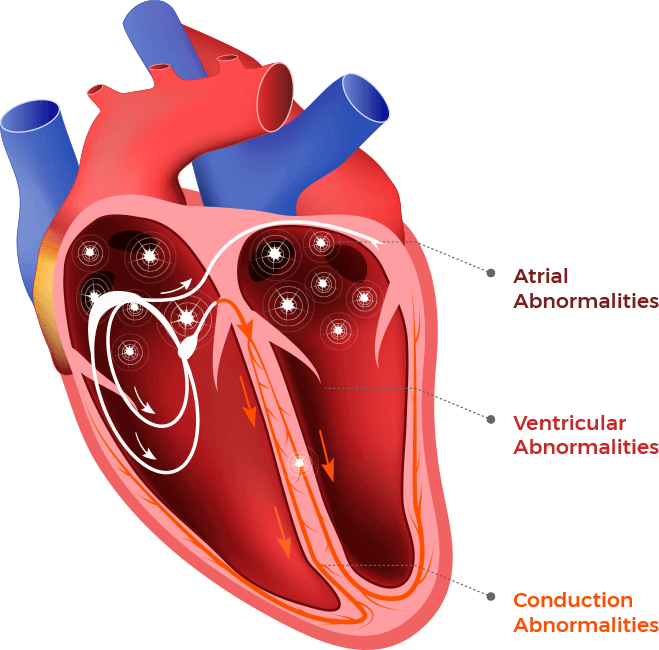
Arrhythmias are abnormal heart rhythms.
The normal electrical signals of the heart that control the heart beat are disrupted during arrhythmias. Arrhythmias are not specific to DCM; they can occur in individuals who do not have DCM. However, there are certain arrhythmias that commonly occur in people with DCM. These are the arrhythmias we will discuss.
There are three categories of arrhythmias that commonly occur in people with DCM:
- Those that originate in the atria, the upper chambers of the heart
- Those that originate in the ventricles, the lower, pumping chambers of the heart
- Those resulting from abnormalities in the electrical pathways of the heart
Some arrhythmias cause palpitations, the sense that the heart is “skipping a beat,” beating too fast, or beating very hard. This can last for seconds to minutes, or even, occasionally, for hours. With rapid heart rates, individuals may feel dizzy or lightheaded, or experience shortness of breath with minimal activity.
A more severe symptom of arrhythmias is called syncope, the medical term for complete loss of consciousness. Other common terms used for syncope include “a blackout spell” or “a fainting spell.” Because syncope may be caused by more dangerous arrhythmias, it always requires immediate medical attention.
Sudden death, or sudden cardiac death, is the term used to describe syncope resulting from an arrhythmia that is accompanied by full cardiac arrest (loss of heart rate, blood pressure, and breathing). If someone suffers an episode of sudden cardiac death, they must undergo successful cardiopulmonary resuscitation to survive. However, at times, it is possible that the lethal arrhythmia may stop by itself and the person may regain a normal heart rate, blood pressure, and breathing. If a person survives an episode of sudden cardiac death, emergency medical treatment is needed to evaluate, treat, and prevent future episodes from occurring.
> Click on the heart rhythm abnormality for detailed information and personal videos.
Atrial Abnormalities View Video
The two most common atrial arrhythmias that occur in persons with DCM are atrial fibrillation and atrial flutter. These are two distinct types of arrhythmias, but they are often related to one another. Atrial fibrillation is the most common abnormal heart rhythm. Atrial flutter is a more organized heart rhythm abnormality and often originates from a very specific area in the atria.
Ventricular Abnormalities View Video
Ventricular abnormalities are electrical signals that originate from the ventricles (bottom pumping chambers of the heart). The presence of ventricular abnormalities often indicates that heart muscle disease is present. There are three main categories of ventricular abnormalities that commonly occur in DCM and can be very significant: Premature Ventricular Complexes, Ventricular Tachycardia, and Ventricular Fibrillation.
Conduction Abnormalities View Videos
The arrhythmias caused by conduction abnormalities include those with the term “block” in them. Conduction abnormalities refer to abnormalities in the well-defined electrical pathways of the heart. The most significant of conduction abnormalities in DCM are second and third-degree heart block and Bundle Branch Block.
Click to Explore:








